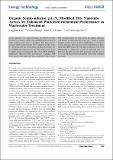Files in this item
Organic semiconductor g-C3N4 modified TiO2 nanotube arrays for enhanced photoelectrochemical performance in wastewater treatment
Item metadata
| dc.contributor.author | Liu, Lingjuan | |
| dc.contributor.author | Zhang, Guan | |
| dc.contributor.author | Irvine, John Thomas Sirr | |
| dc.contributor.author | Wu, Yucheng | |
| dc.date.accessioned | 2015-09-17T12:10:03Z | |
| dc.date.available | 2015-09-17T12:10:03Z | |
| dc.date.issued | 2015-07 | |
| dc.identifier | 192105374 | |
| dc.identifier | a4119952-5d8c-4a61-b995-07a280fdd6bc | |
| dc.identifier | 84994237237 | |
| dc.identifier | 000360840900012 | |
| dc.identifier.citation | Liu , L , Zhang , G , Irvine , J T S & Wu , Y 2015 , ' Organic semiconductor g-C 3 N 4 modified TiO 2 nanotube arrays for enhanced photoelectrochemical performance in wastewater treatment ' , Energy Technology , vol. 3 , pp. 982-988 . https://doi.org/10.1002/ente.201500114 | en |
| dc.identifier.issn | 2194-4296 | |
| dc.identifier.other | ORCID: /0000-0002-8394-3359/work/68280864 | |
| dc.identifier.uri | https://hdl.handle.net/10023/7499 | |
| dc.description | This work was supported by China Scholarship Council (CSC), Royal Society of Edinburgh (RSE) and Engineering and Physical Sciences Research Council (EPSRC). Date of Acceptance: 27/05/2015 | en |
| dc.description.abstract | g-C3N4 sensitized TiO2 nanotube arrays (g-C3N4/TNTs) were fabricated by a simple solid sublimation and transition (SST) method using urea as precursor. The photoelectrochemical (PEC) performances were evaluated in this work. It is proposed that the g-C3N4 layer can play dual roles: surface sensitization and passivation of TNTs surface trap states to inhibit charge recombination. The g-C3N4/TNTs exhibited significantly improved PEC performance compared with TNTs under blue light (460 nm) irradiation. The g-C3N4/TNTs prepared from 3 g urea showed the highest photocurrent density of ca. 65 μA cm-2, which is almost 10 times as high as that of TNTs. Furthermore, g-C3N4/TNTs showed enhanced photoelectrocatalytic degradation of methylene blue (MB) under the blue light irradiation. The stable performance of degradation of MB in the multicycle tests suggests that the hybrid g-C3N4/TNTs electrode could be used as a low-cost photoelectrode material in wastewater treatment process. | |
| dc.format.extent | 1931685 | |
| dc.language.iso | eng | |
| dc.relation.ispartof | Energy Technology | en |
| dc.subject | g-C3N4 | en |
| dc.subject | TiO2 nanotube arrays | en |
| dc.subject | Solid sublimation and transition | en |
| dc.subject | Visible light | en |
| dc.subject | Photoelectrochemcial performance | en |
| dc.subject | QD Chemistry | en |
| dc.subject | NDAS | en |
| dc.subject.lcc | QD | en |
| dc.title | Organic semiconductor g-C3N4 modified TiO2 nanotube arrays for enhanced photoelectrochemical performance in wastewater treatment | en |
| dc.type | Journal article | en |
| dc.contributor.sponsor | EPSRC | en |
| dc.contributor.institution | University of St Andrews. School of Chemistry | en |
| dc.contributor.institution | University of St Andrews. EaSTCHEM | en |
| dc.identifier.doi | 10.1002/ente.201500114 | |
| dc.description.status | Peer reviewed | en |
| dc.identifier.grantnumber | EP/K015540/1 | en |
This item appears in the following Collection(s)
Items in the St Andrews Research Repository are protected by copyright, with all rights reserved, unless otherwise indicated.

